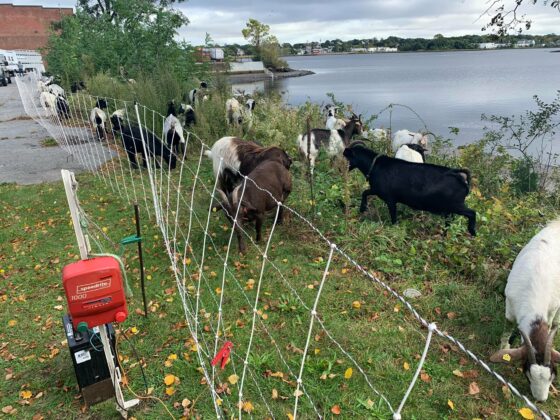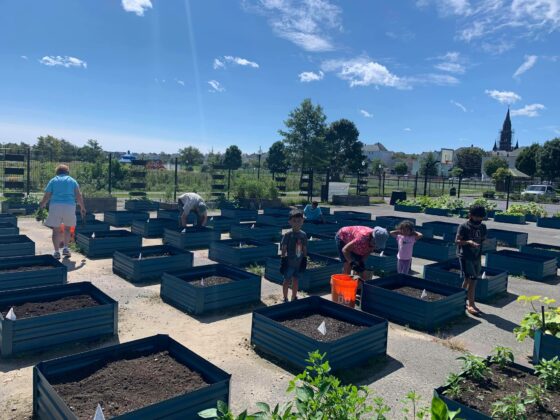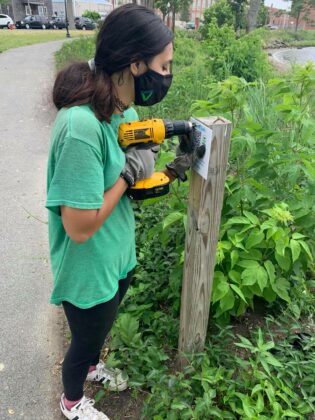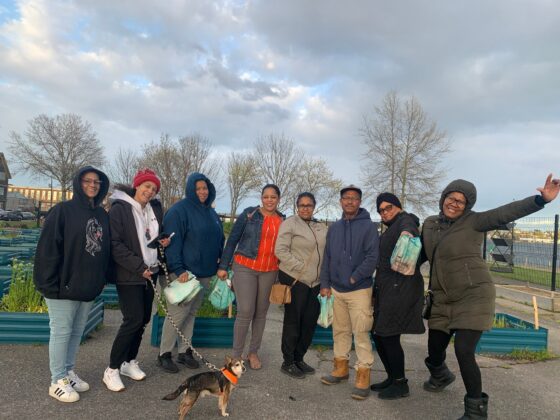Getting the Community Outside Through Park Reactivation and Educational Engagement
While the majority of the population of New Bedford, MA, lives within walking distance of parks or open public lands, much of the space is underutilized. When Groundwork Southcoast (GWSC) first started work on Riverside Park, a long-untended brownfield site along the Acushnet River, the property was overgrown with invasives and used for dumping everything from trash to used needles. Residents didn’t feel safe going there, so certain sections of the park sat mostly vacant.

After a lengthy restoration process led by the City of New Bedford Park Department and GWSC, Riverside Park is now a welcoming waterfront green space with community garden beds, a walking trail, fruit trees, and native plants, providing needed environmental services to the community, from air purification, to shade and flood mitigation.
In addition to these environmental improvements, when designed for and by the community, green spaces provide recreation and social interaction opportunities, stress and anxiety relief, and mental health benefits.
But, in communities like New Bedford, with a deep legacy of underinvestment in the accessibility of public spaces, it’s not enough to just reclaim the land for residents to access the social and physical health benefits of green spaces. We also need to change the narrative about existing park spaces to help residents see their community in new ways.
transforming the land

At GWSC, this process begins with community leadership. In 2020, the team began a multi-step transformation of Riverside Park into the city’s first fully fenced-in urban farm and community garden, in response to residents’ desire for more community-focused green space. Reactivating Riverside Park and launching the new urban garden was a lengthy project that included goat-scaping to clear invasive species, weeding, native plant reseeding, removing dead trees, and adding fences. The Green Team also planted fourteen fruit trees, some of which are already bearing fruit for residents to pick as they wish. Since the restored Riverside Park opened, all of the 150+ garden beds have been quickly adopted each season by residents and community members have been going to the park more often, citing that they feel safer and more included in the space.
As Eric Andrade, Impact Director at GWSC, explains, “All of our work is community-led and, specifically for Riverside Park, neighborhood-led. We have a show-and-listen model, so all the work that we do comes directly from feedback from the community and our young people who all live in the community where they work.”

A central element of Riverside Park is the raised beds which are adopted by low-income residents to grow their own produce. Eric says, “We’re investing in what the community wants. We never had food access on the table when we started. It was the young people and the community that said we want a place to grow food and that has turned into a community garden with 170 adoptable raised beds all for low-income folks. But that initially wasn’t on our radar. So we take the feedback and go with it.” With GWSC’s Green Team – an employment and community environmental stewardship program for high school-aged youth – on hand to provide support, at least 1,500 pounds of fresh produce is grown on the site annually.
reshaping the narrative
To increase awareness about the new outdoor spaces, and (re)introduce community members to the beauty of their neighborhood, GWSC partnered with the City of New Bedford Park Department to reactivate the walking trail along the waterfront in Riverside Park for residents to enjoy.
The Green Team spearheaded the Adventure Walk, an educational supplement to the walking trail, as one of its annual legacy projects designed to leave a lasting impact on the community. With the approval of the city’s Park Board, Green Team youth created and installed QR codes along the path for trail users to scan to learn more about the park and community garden, the history of dumping and pollution in the Acushnet River, outdoor safety tips, best practices for interacting with local birds and wildlife, and future plans for Riverside Park.

This was the first time GWSC experimented with QR codes, which eliminated the need for large signs and reduced the amount of space needed to share information with trail users. These QR code-linked pages are available in English, Spanish, and Portuguese, the three most prominent languages in New Bedford, and the information associated with the codes is also posted directly on the GWSC website for residents who don’t have access to a smartphone. By the end of the year, updated Adventure Walk educational content will be available for all on the GWSC website. The Green Team also created a video on the website explaining how to use the QR codes for community members who may be unfamiliar.
GWSC’s Riverside Park reactivation and Adventure Walk have been quite successful, expanding community engagement with local green spaces and providing opportunities for residents to learn more about their community. “The more presence and investment that Riverside Park gets, the more residents feel comfortable walking around,” Eric said. There is even a group of residents who are planning to start a walking club in the park.

The Green Team now wants to replicate the Adventure Walk model within two, mile-long wooded trail systems in New Bedford. They are particularly focused on encouraging residents from environmental justice neighborhoods to explore their local outdoor spaces through education. Just as with the Riverside Park activation and the Adventure Walk, the GWSC team is excited to see more community spaces come to life based on residents’ feedback. Eric knows that “these projects are working because they are coming directly from the community.”
To learn more, visit Groundwork Southcoast.
